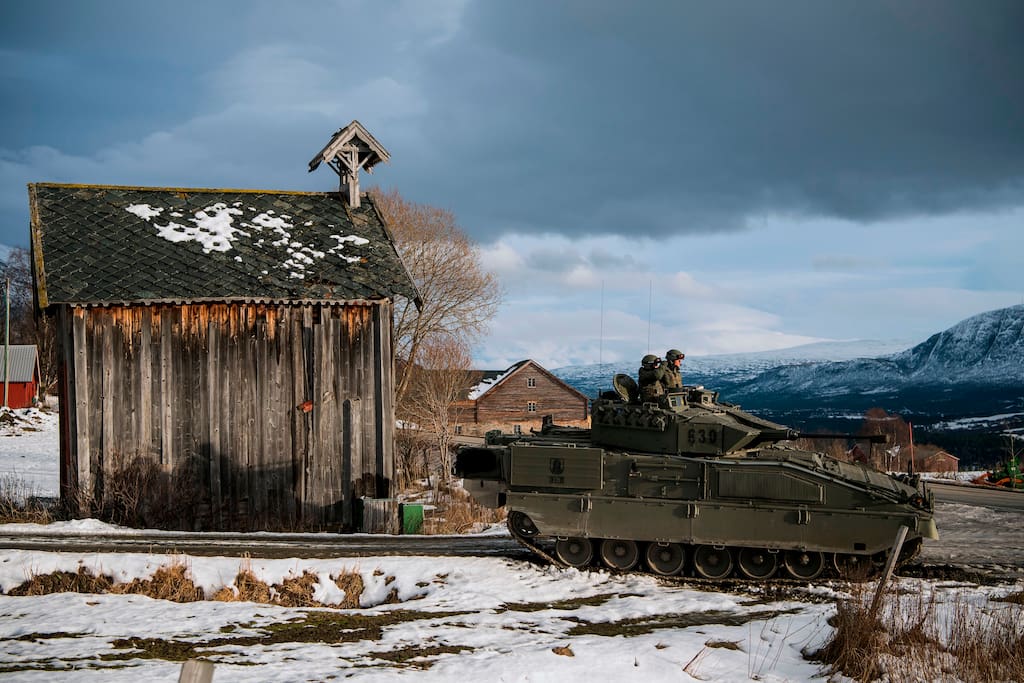US Military Buildup In Northern Europe: A Response To Rising Russia Tensions

Table of Contents
The escalating tensions between Russia and NATO have brought a significant increase in US military assets and personnel to Northern Europe. This unprecedented military buildup raises critical questions about regional security, the strategic goals of the United States, and the potential for further escalation. This article analyzes the reasons behind this dramatic increase in US military presence, its impact on regional stability, and potential future scenarios. We'll explore the interplay between US military deployments, Russia's actions, and the broader geopolitical landscape of Northern Europe.
Strategic Rationale Behind the US Military Buildup
The surge in US military forces in Northern Europe is driven by a complex interplay of strategic factors, primarily focused on deterrence and defense.
Deterrence and Defense of NATO Allies
The increased US military presence serves as a powerful deterrent against potential Russian aggression. This is crucial for reassuring NATO allies, particularly the Baltic states (Estonia, Latvia, and Lithuania), which feel particularly vulnerable to Russian pressure. The deployment of substantial military forces sends a clear message that an attack on one NATO member is considered an attack on all, invoking the crucial Article 5 of the NATO treaty – the principle of collective defense. This concept, known as "extended deterrence," aims to dissuade Russia from any military adventurism.
- Examples of deployed assets: The US has deployed additional troops, armored brigades, fighter jets (including F-35s and F-22s), and advanced missile defense systems to various locations in Northern Europe.
- Enhanced military exercises: Joint military exercises involving US and NATO forces have increased significantly in frequency and scale, showcasing combined military capabilities and demonstrating a unified front against potential threats.
- Reinforced air and naval presence: The US Navy has increased its naval presence in the Baltic Sea, conducting regular patrols and exercises to monitor Russian naval activity. Air patrols have also increased to monitor Russian air traffic and enforce NATO airspace.
Countering Russian Military Activities
Russia's annexation of Crimea in 2014 and its ongoing military activities near the borders of NATO members, including large-scale military exercises and the deployment of advanced weaponry, have significantly heightened tensions. These actions have prompted a robust US response aimed at countering Russian military capabilities and deterring further aggression.
- Russian military build-up: Russia has significantly increased its military presence in Kaliningrad, a strategically important Russian exclave bordering NATO members Poland and Lithuania. This includes the deployment of advanced missile systems, posing a direct threat to neighboring countries.
- Hybrid warfare tactics: Russia's use of information warfare, disinformation campaigns, and other hybrid warfare tactics against NATO allies has been a factor in the US military response. The aim is to counter these activities and protect the integrity of NATO member states.
- Intelligence gathering and monitoring: The increased US military presence enhances intelligence gathering capabilities, enabling better monitoring of Russian military activities and providing crucial early warning of potential threats.
The Impact on Regional Security
The US military buildup in Northern Europe has far-reaching consequences, presenting both opportunities and risks for regional security.
Increased Stability or Heightened Tensions?
The increased US military presence can be viewed as both a stabilizing and destabilizing factor.
- Increased stability: The deterrent effect of the US military buildup can prevent potential Russian aggression, reassuring NATO allies and maintaining regional stability. The clear demonstration of commitment to collective defense strengthens the credibility of NATO's deterrence strategy.
- Heightened tensions: The increased military presence could be perceived by Russia as a provocative act, leading to further escalation of tensions and an increased risk of miscalculation or accidental conflict. This highlights the importance of continued diplomatic engagement and de-escalation efforts. The risk of an incident, even accidental, dramatically increases with a higher concentration of military forces.
Economic and Social Impacts in Host Nations
The presence of US troops creates both economic opportunities and potential social challenges for host nations.
- Economic benefits: The US military spending boosts local economies through increased employment, infrastructure development, and contracts for local businesses. The influx of US personnel also stimulates the service sector.
- Social consequences: The increased presence of foreign troops can strain local resources, particularly infrastructure and social services. Potential social friction and challenges related to cultural differences may also arise. This requires careful management and communication between the US military and host nation communities.
Future Scenarios and Predictions
Predicting the future is inherently complex, but several potential scenarios regarding the US military buildup in Northern Europe need to be considered.
Potential for Further Escalation
Several factors could lead to a further escalation of tensions:
- Cyber warfare: Increased cyberattacks targeting critical infrastructure or government systems could lead to a significant escalation.
- Hybrid warfare: The continued use of hybrid warfare tactics by Russia, combined with potential miscalculations or accidental incidents, could spark a larger conflict.
- Accidental incidents: A misunderstanding or accidental encounter between Russian and NATO forces could trigger an unintended military escalation.
Long-Term Implications of the Military Buildup
The long-term consequences of the sustained US military presence in Northern Europe are uncertain.
- New Cold War or Détente?: The current situation bears some resemblance to the Cold War, but the dynamics are different. The future could see a return to a period of détente, or the relationship could continue its trajectory towards increased tension. The outcome is heavily reliant on actions taken by all involved parties.
- Future of NATO's Role: NATO's role in the region is likely to remain significant, even if tensions ease. The alliance's collective defense posture will continue to adapt to the evolving security challenges.
Conclusion
The US military buildup in Northern Europe is a direct response to rising tensions with Russia. The strategic rationale centers on deterring potential Russian aggression and defending NATO allies. While this buildup offers a degree of stability, it also carries the risk of escalating tensions and necessitates continued diplomatic efforts. The long-term implications for regional security and the relationship between Russia and the West remain uncertain, requiring ongoing monitoring and careful consideration of future scenarios.
Stay informed about the ongoing US military buildup in Northern Europe and its impact on Russia tensions. Understanding this complex geopolitical situation is crucial for navigating the challenges ahead.

Featured Posts
-
 Gunners Eye Striker Signing Tottenhams 58m Bid Faces Competition
May 28, 2025
Gunners Eye Striker Signing Tottenhams 58m Bid Faces Competition
May 28, 2025 -
 Cubs Vs Padres Series Recap Winning Plays And Critical Errors
May 28, 2025
Cubs Vs Padres Series Recap Winning Plays And Critical Errors
May 28, 2025 -
 One Inning Sinks Angels Chances Kochanowicz Takes The Loss
May 28, 2025
One Inning Sinks Angels Chances Kochanowicz Takes The Loss
May 28, 2025 -
 Info Cuaca Jawa Timur Hujan Diprediksi Terjadi Pada 6 Mei 2024
May 28, 2025
Info Cuaca Jawa Timur Hujan Diprediksi Terjadi Pada 6 Mei 2024
May 28, 2025 -
 Wes Andersons Latest Style Without Substance A Review
May 28, 2025
Wes Andersons Latest Style Without Substance A Review
May 28, 2025
